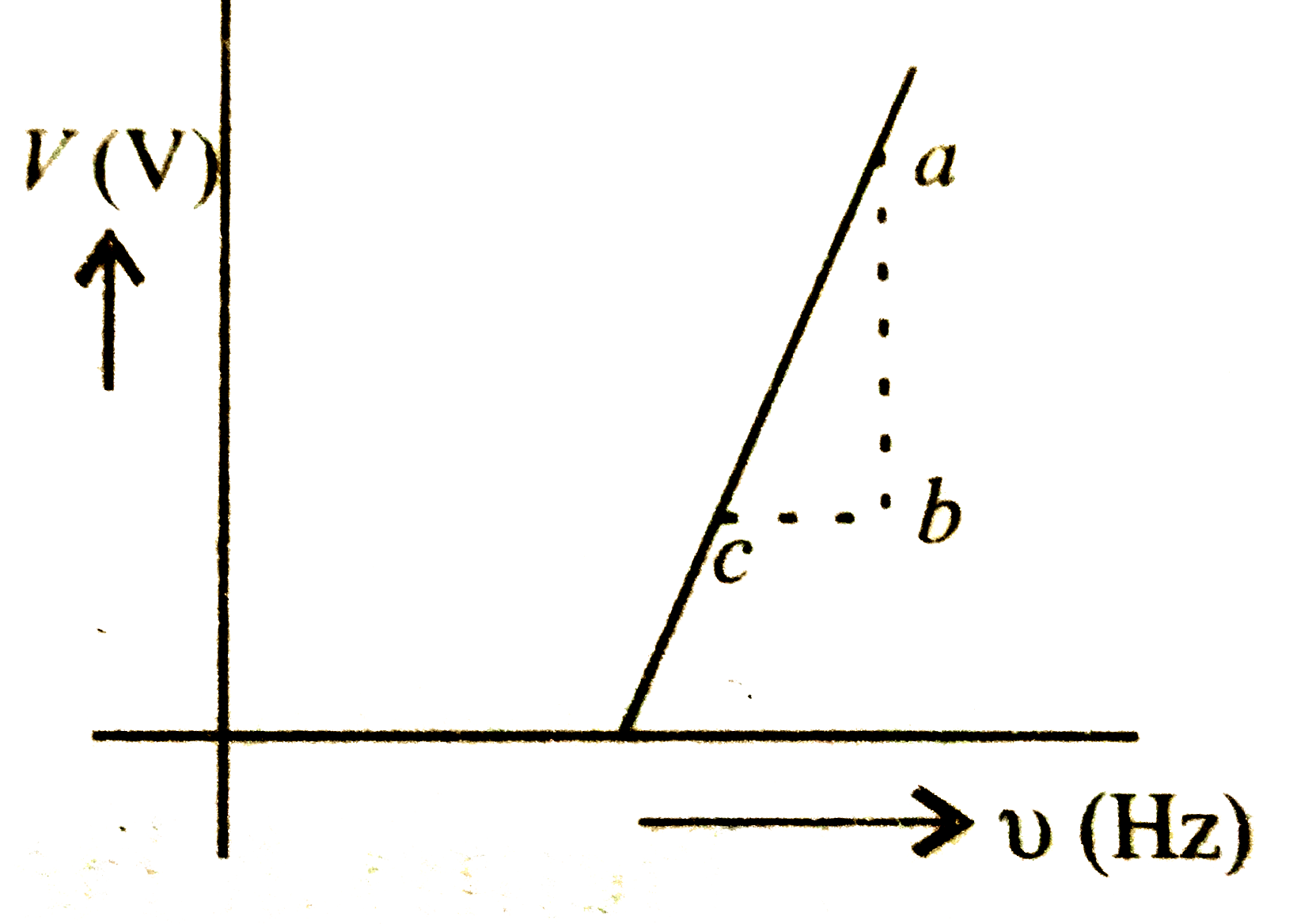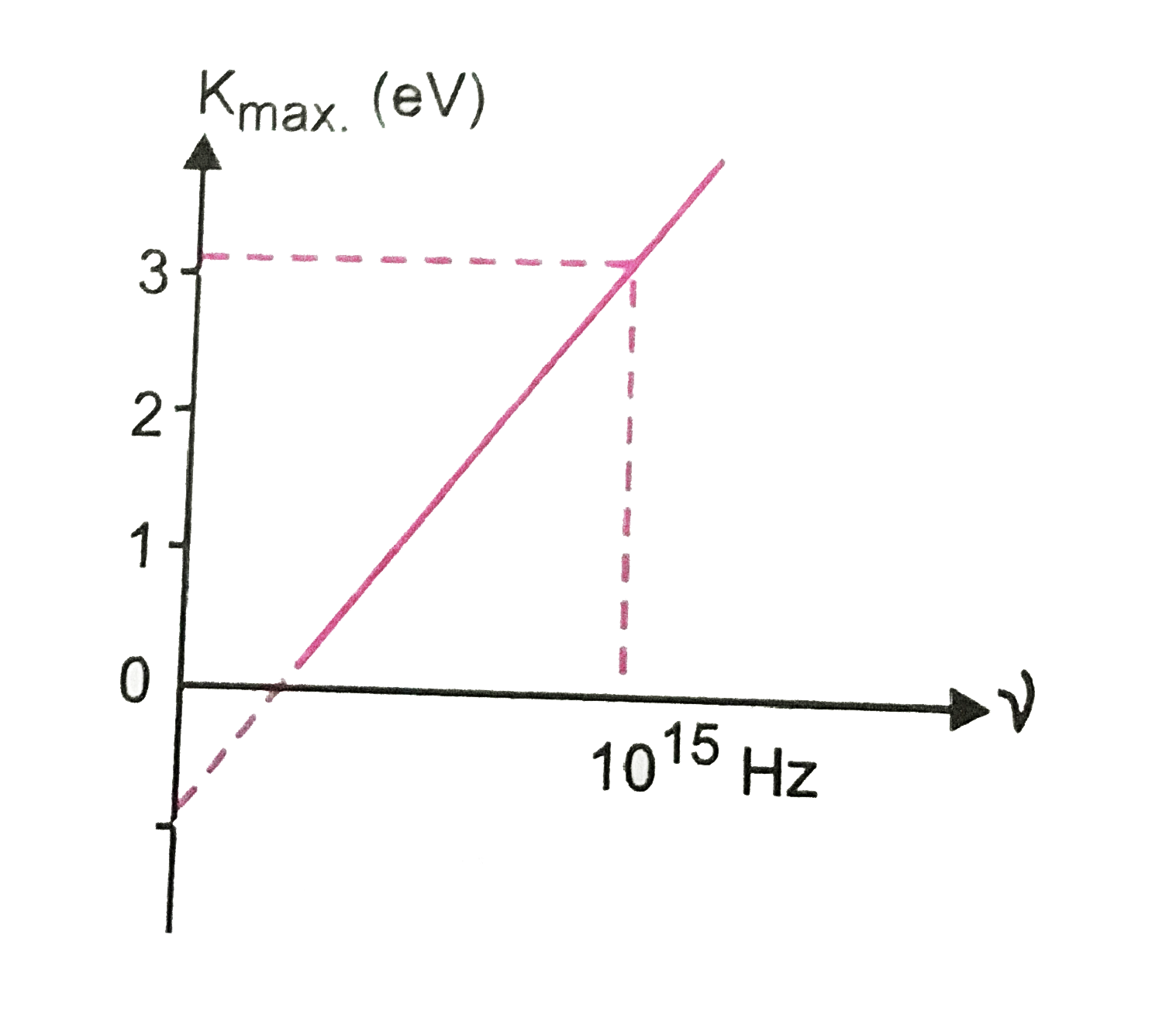Complete Solutions to Einstein'S Photoelectric Equation : Energy Quantum Of Radiation of chapter DUAL NATURE OF RADIATION AND MATTER of Class 12 book with complete answers and questions
| Class 12 | PHYSICS |
| Chapter | DUAL NATURE OF RADIATION AND MATTER |
| NCERT FINGERTIPS | Einstein'S Photoelectric Equation : Energy Quantum Of Radiation |
| Number Of Questions | 23 |
| Academic Year | 2023-24 |
According to Einstein's photoelectric equation , the graph between the kinetic energy of photoelectrons ejected and the frequency of incident radiation is
View SolutionAccording to Einstein's photoelectric equation, the plot of the maximum kinetic energy of the emitted photoelectrons from a metal versus frequency of the incident radiation gives a straight line whose slope
View SolutionIn a photoelectric experiment, the graph of frequency v of incident light (in Hz) and stopping potential V (in V) is as shown in the figure. Planck's constant is (e is the elementary charge)

View SolutionA student performs an experiment on photoelectric effect using two materials `A` and `B`. A plot of stopping potential `(V_(0))` vs frequency `(nu)` is as shown in the figure.

The value of Planck's constant obtained from the experiment for both `A` and `B` respectively is
(Given electric charge of an electron `=1.6xx10^(-19)C)`
View SolutionLight of wavelength `0.6 mum `from a sodium lamp falls on a photocell and causes the emission of photoelectrons for which the stopping potential is 0.5 V. With wavelength `0.4 mum` from a sodium lamp, the stopping potential is 1.5 V. With this data , the value of h/e is
View SolutionWhen the photons of energy `hv` fall on a photosensitive metallic surface of work function `hv_(0)`, electrons are emitted are from the surface. The most energetic electron coming out of the surface have kinetic energy equal to
View SolutionThe photoelectric threshold 4v is incident on the metal is v. When light of frequency 4v is incident on the metal, the maximum kinetic energy of the emitted photoelectron is
View SolutionPhotoelectric emission occurs only when the incident light has more than a certain minimum
View SolutionThe work function for Al, K and is 4.28 eV, 2.30 eV and 5.65 eV respectively. Their respective threshold frequencies would be
View SolutionThe photoelectric threshold wavelength for silver is `lamda_(0)`. The energy of the electron ejected from the surface of silver by an incident wavelength `lamda(lamdaltlamda_(0))` will be
View SolutionA photon of energy E ejects a photoelectron from a metal surface whose work function is `phi_(0)`. If this electron enters into a uniform magnetic field of induction B in a direction perpendicular to the field and describes a circular path of radius r, then the radius r, is given by, (in the usual notation)
View SolutionTwo identical photocathodes receive light of frequencies `v_(1) and v_(2)`. If the velocities of the photoelectrons (of mass m) coming out are respectively `v_(1) and v_(2)`. then
View SolutionA metallic surface is irradiated by a monochromatic light of frequency `v_(1)` and stopping potential is found to be `V_(1)`. If the light of frequency `v_(2)` irradiates the surface, the stopping potential will be
View SolutionIf `K_(1) and K_(2)` are maximum kinetic energies of photoelectrons emitted when light of wavelength `lambda_(1) and lambda_(2)` respectively are incident on a metallic surface. If `lambda_(1)=3lambda_(2)` then
View SolutionThe work function of cesium is 2.14 eV. The threshold frequency of cesium is
View SolutionIn the question number 33, find the wavelength of the incident light if the stopping potential is 0.6 V.
View Solutionrepresents a graph of most energetic photoelectrons `K_(max)`(in eV) and frequency v for a metal used as cathode in photoelectrons experiment. The threshold frequency of light for the photoelectric emission from the metal is

View SolutionLight of frequency `7.21xx10^(14)Hz` is incident on a metal surface. Electrons with a maximum speed of `6.0xx10^(5)ms^(-1)` are ejected from the surface. What is the threshold frequency for photoemission of electrons? `h=6.63xx10^(-34)Js, m_(e)=9.1xx10^(-31)kg`.
View SolutionFor a certain metal v is the five times of `v_(0)` and the maximum velocity of coming out photons is `8 xx 10^(6)m//s`. If `v = 2v_(0)`, then maximum velocity of photoelectrons will be
View SolutionA light of wavelength 600 nm is incident on a metal surface. When light of wavelength 400 nm is incident, the maximum kinetic energy of the emitted photoelectrons is doubled. The work function of the metals is
View SolutionThe threshold frequency of a certain metal is `3.3xx10^(14)Hz`. If light of frequency `8.2xx10^(14)Hz` is incident on the metal, predict the cut off voltage for photoelectric emission. Given Planck's constant, `h=6.62xx10^(-34)Js`.
View SolutionA and B are two metals with threshold frequencies `1.8xx10^(14)Hz and 2.2xx10^(14)Hz`. Two identical photons of energy of 0.825 eV each are incident on them. Then photoelectrons are emitted in take `h=6.6xx10^(-34)J//s`
View SolutionThe stopping potential as a function of the frequency of the incident radiation is plotted for two different photoelectric surfaces `A` and `B` . The graphs show that work function of `A` is

View Solution
Einstein'S Photoelectric Equation : Energy Quantum Of Radiation questions and complete solutions for chapter DUAL NATURE OF RADIATION AND MATTER of NCERT FINGERTIPS PHYSICS (HINGLISH) of Class 12
All Exercises from NCERT FINGERTIPS Class 12 PHYSICS DUAL NATURE OF RADIATION AND MATTER
- Assertion And Reason
- Davisson And Germer Experiment
- Einstein'S Photoelectric Equation : Energy Quantum Of Radiation
- Electron Emission
- Experimental Study Of Photoelectric Effect
- Higher Order Thinking Skills
- Introduction
- NCERT Exemplar
- Particle Nature Of Light : The Photon
- Photoelectric Effect
- Wave Nature Of Matter